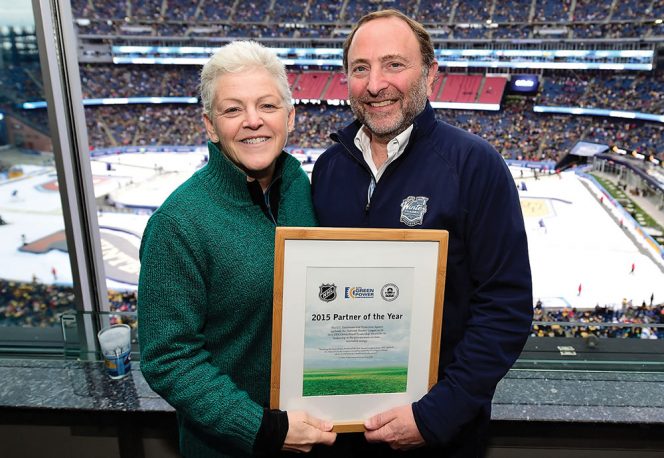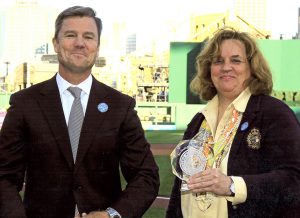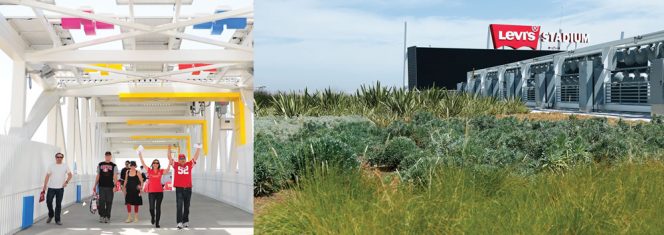Professional and collegiate sports teams, and their leagues, develop vital partnerships to green their venues, operations and supply chain, while engaging fans to adopt sustainable behaviors.
Nora Goldstein
BioCycle June 2016
 An overarching theme of the 2016 Green Sports Alliance Summit, June 28-30 in Houston, Texas, is The Power of Partnerships. “Throughout the program speakers will share how unique partnerships are helping amplify the sports greening movement across the globe and positioning the sports industry to make significant change in the communities where we live and play,” states the introduction to the agenda for the 3-day Summit.
An overarching theme of the 2016 Green Sports Alliance Summit, June 28-30 in Houston, Texas, is The Power of Partnerships. “Throughout the program speakers will share how unique partnerships are helping amplify the sports greening movement across the globe and positioning the sports industry to make significant change in the communities where we live and play,” states the introduction to the agenda for the 3-day Summit.
“Partnerships have been at the core of sports greening initiatives,” notes Scott Jenkins, Chair of the Green Sports Alliance Board of Directors, and General Manager of Mercedes-Benz Stadium in Atlanta, Georgia. “To do anything, it takes a team of people who are committed and have a vision. And it requires bringing in partners with different expertise but who share common visions and goals. Those partners include the supply chain, food service, housekeeping, utilities and the community.”
Jenkins’ career in stadium operations includes being an early adopter of sports greening. “My involvement started with the very early days of the green sports movement in 2003-2004 in Philadelphia, where I was vice-president of operations at Lincoln Financial Field, home of the Philadelphia Eagles,” he recalls. “The owner of the Eagles partnered with the National Resources Defense Council (NRDC) and the Sexton Group, which creates sustainability platforms, to start the team’s Go Green program. As VP of stadium operations, I knew recycling was important, e.g., bottles, cans and papers. And I was familiar with water and energy conservation. What I didn’t know were all the things that sports do and can do in regard to greening, and the potential to use the power of the teams to influence behavior and change the experience people have at events.”
Market Transformation
Those pioneering years eventually led to the founding of the Green Sports Alliance (GSA) in 2010, and launch of the annual Green Sports Alliance Summit in 2011. Today, Alliance members represent more than 300 professional and collegiate sports teams and venues from 20 different leagues and 14 countries. All National Hockey League and Major League Baseball teams are members. Concurrent with growth of the GSA has been a market transformation that has lowered the bar for teams and venues to go green. “The transformation is dramatic,” notes Jenkins, “and with GSA, it has happened across three major platforms: Greening team venues and operations, greening of the supply chain, and engaging fans and using sports as a lever to change behavior.”
He adds that the best examples of this market transformation are in the zero waste, renewable energy and lighting sectors. “Ten years ago, if a venue had a 10 to 15 percent waste diversion rate, that was pretty good. But innovation on the part of food service partners and compostable products suppliers opened up the opportunity to make zero waste not just aspirational, but achievable. When teams and venues are not mindful of what they are buying, or are limited on what is available, it is hard to envision how to change. Today, you can get anything you need for food service in a compostable version. Teams are not limited in thinking 30 percent diversion is the norm. Seventy percent is good, and 90 percent is doable.”
Jenkins emphasizes that his success on the zero waste front was due in large part to partnerships. After his time with the Eagles, he joined the Seattle Mariners as vice president of Safeco Field ballpark operations. “It was a great situation, with Cedar Grove Composting as our organics processor, Center Plate as our food service operator and Aramark providing cleaning services,” he says. “We were able to do cool things around Zero Waste that I never thought would be possible. We could not have done it without those partners.”
On the energy side, renewable energy has become affordable, Jenkins notes. And the performance and durability of LED lighting has led to its utilization at many venues. “In short, sports greening would not be where it is today without innovation in the supply chain and the marketplace,” notes Jenkins. “Solutions are available that make sustainability a no brainer. Greening has become a matter of will. Teams and venues need to be deliberate about taking on sustainability initiatives. It’s hard initially, and can cost money. But making these changes can also save money.”

The retractable roof of Mercedes-Benz Stadium (MBS), when open (far left), will take advantage of natural light. Deployment of 4,000 solar panels (below), along with use of LED lighting, will significantly reduce use of power from the grid. Images courtesy of Mercedes-Benz Stadium
Mercedes-Benz Stadium
Jenkins joined AMB Sports & Entertainment Group, owner of the Atlanta Falcons and the Atlanta United FC professional soccer team, in February 2014 as General Manager of Mercedes-Benz Stadium (MBS), which will open in 2017. Arthur M. Blank, Chair of AMB Group, LLC (the parent organization), wanted to push the envelope of sustainable operations at MBS, and hired Jenkins to take the lead. The goal of the new stadium is to receive the U.S. Green Building Council’s LEED Platinum certification, the highest level available.
“We were originally tracking for LEED Gold, but are getting closer to Platinum, which we are now pursuing,” explains Jenkins. “We will get every available LEED point for water, building in 40 percent more water efficiency than the Georgia Dome, current home of the Falcons. There will be a 34 percent reduction in energy, and we have 4,000 solar panels deployed as part of the project. And Levy Restaurants, MBS’s food service contractor, will be sourcing farm-to-table and organic offerings to serve throughout the venue.” An LED lighting system will use 60 percent less electricity than the more traditionally used metal halides; a retractable roof that when open, will maximize the amount of outdoor lighting.
The storm water system will have capacity to handle over 2 million gallons at any one time. Captured rainwater from the stadium and site will flow to a one million gallon storm water vault that feeds a 680,000-gallon cistern. The water will be used for the stadium’s cooling towers and landscape irrigation. “The neighborhood where MBS is located has been subject to combined sewer overflows (CSOs) for a long time,” says Jenkins, caused by storm water overwhelming the sewer pipes. “This system should have a big impact on mitigating CSOs.”
MBS is seeking a composting facility that can process its organics stream. “Not having a commercial composter lined up yet is the biggest hurdle we have,” he adds. “A lot of folks are working on making that happen, but that infrastructure is not available yet.”

Levy Restaurants, MBS’ food service provider, and Westside Works, offer an 8-week culinary arts class (right) open to residents of the Westside neighborhood adjacent to the stadium. Juliet Peters, culinary instructor (below), notes that 100 percent of the graduates have been placed for employment.
Career Training And Placement
The Westside neighborhood where MBS is located has faced economic hardships for many years. About 70 percent of the housing stock is not occupied. “Martin Luther King lived in that neighborhood, which has a rich history,” notes Jenkins. “Both Morehead and Spellman Colleges are nearby. The Arthur M. Blank Family Foundation is very committed to helping revitalize the Westside community.” That commitment includes a $15 million investment in Westside Works, a community development organization, to launch a career training and job placement program about two years ago. “Already, over 100 people have been trained to work in construction, including at MBS,” he adds.
When MBS issued a request for proposals for a food service provider, one respondent included establishment of a culinary arts class to train neighborhood residents for jobs as chefs at MBS as well as other venues. That provider, Levy Restaurants, won the bid and offers a culinary course through Westside Works. The 8-week course, launched in August 2014, introduces students to kitchen safety protocols, international cuisine, baking and pastry, and restaurant simulations. “The program finishes with a food certification exam [ServSafe™] administered by Levy Restaurants that tests the students in food safety and handling,” explains Juliet Peters, Culinary Instructor who designed the class. “So far, 100 percent of the students are placed for employment, either with Levy Restaurants or at other dining establishments in metro Atlanta. The certification pass rate is close to 90 percent, as some students struggle with literacy.” Peters assists graduates with job placement. Westside Works offers computer and literacy classes that help students round out their skills.
Many students in the Westside Works career training programs (six in total, including culinary) have experienced homelessness and incarceration, and want to earn a living wage to support themselves and their families. “Mr. Blank recognized the need to identify, and be realistic about, the population Westside Works is servicing,” explains Peters. “For example, I describe our culinary class as 50 percent working with food, and the other half having nothing to do with food. That portion teaches soft skills — students knowing how they are getting to class and getting here on time. If they can’t get to class on time — which is 5 days a week for 8 weeks — or they constantly have to leave early, it is likely they will be the same way in a the job.”
Students learn how to move around in a busy kitchen safely, speak to one another, take inventory and minimize waste. “We have knife drills everyday,” she notes, “which teach both how to waste less, and connect the fact that excess waste equates to excess food costs.” Peters goes to the Atlanta Food Bank regularly to pick up produce that is past its prime and is available for free. “I make a lesson out of it that day, for example, making tomato sauce out of overripe tomatoes and then showing students how to can the sauce to preserve it. And it’s a great way to introduce them to vegetables or fruits they may not know about, such as artichokes and portabella mushrooms.”
A team from the Westside Works’ construction class built a garden bed at MBS that the culinary students tend. “All the produce is used in the class,” adds Peters. When the stadium opens, it will feature additional edible gardens and landscapes.
League Partnerships
While individual teams and the venues they play in are stepping up to sustainability, the leagues themselves are increasingly committing themselves to green practices. The National Hockey League (NHL) is a case in point. “We take environmental sustainability seriously and prioritize it as a league,” notes Omar Mitchell, the NHL’s vice-president of corporate responsibility. “’NHL Green’ was launched in 2010 as a mandate by our Commissioner, Gary Bettman, to adopt sustainable business practices — both as an organization and for the NHL’s 30 member clubs, which include 23 in the U.S. and 7 in Canada.”
In the introduction to the league’s 2014 Sustainability Report, Bettman stated: “We believe this effort [sustainability] is not only the right thing to do for the environment, but is also a core strategy for the long-term success of our League. We have a vested interest in this cause. As a business, we rely on freshwater to live, work and play. Moreover, to continue to stage world class outdoor hockey events like the NHL Winter Classic … we need winter weather.”
The report notes that ice hockey is perhaps more vulnerable than any other sport to environmental issues, particularly climate change and freshwater scarcity, because “the ability to skate and play hockey outdoors is a critical component of the League’s history and culture,” with players learning to skate outside on frozen lakes, ponds and backyard rinks. Leading up to its 2014 Sustainability Report, the NHL conducted an extensive carbon inventory, which details the greenhouse gas emissions associated with the many facets of its operations, including energy and water use, waste and travel.

EPA Administrator Gina McCarthy presents NHL Commissioner Gary Bettman with EPA’s Green Power Partner of the Year Award. Photo by Patrick McDermott/NHLI via Getty Images
In December 2014, Constellation Energy, an energy services provider (ESP), was selected as the official energy choice of the NHL. The league had been purchasing renewable energy credits (RECs) and carbon credits to offset greenhouse gas emissions for its 2012 and 2013 seasons from another entity. Via its partnership with Constellation Energy, the NHL is provided with enough RECs and carbon offsets for both its 2014-2015, and 2015-2016 GHG emissions, explains Mitchell. “That is the type of commitment we look for in a partnership — a shared value with our objectives and promoting environmental sustainability. This is the first time that any sports league has made a commitment to counterbalance its carbon footprint.”
He adds that having Constellation Energy as a partner provides resources to individual clubs to become more energy efficient, and to create on-site renewable energy, including solar and fuel cells. For example, clubs are working with Constellation to install LED game lights that use 40 to 60 percent less energy than metal halide lights, and “transform how the ice surface is lit.” The NHL received the 2015 Green Power Partner of the Year Award from the U.S. EPA for its green energy initiatives.
Almost all of the NHL clubs participate in food recovery initiatives; in the first year (2010-11 season) over 100 tons of food were donated. About 10 clubs divert organic waste streams to composting. In 2011, to address the issue of freshwater scarcity, the NHL launched a partnership with the Bonneville Environmental Foundation to fund water restoration initiatives, such as water clean up projects, enabling infiltration of rainwater to replenish streams, and planting trees along riverbanks.
To engage hockey fans around this initiative, the NHL created Gallons for Goals. “During the regular season, for every goal scored the NHL pays for the restoration of 1,000 gallons of water,” notes Mitchell. “It’s a way to build understanding around the water scarcity issue. In general, environmental sustainability can be a difficult topic for fans to understand. But at the end of the day, hockey fans — in particular those who learn to play the game outdoors — inherently get the relationship and why the NHL does what it does. They can visualize it and see the value.”













